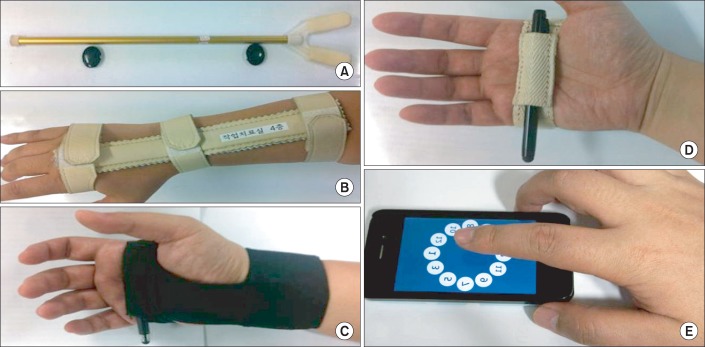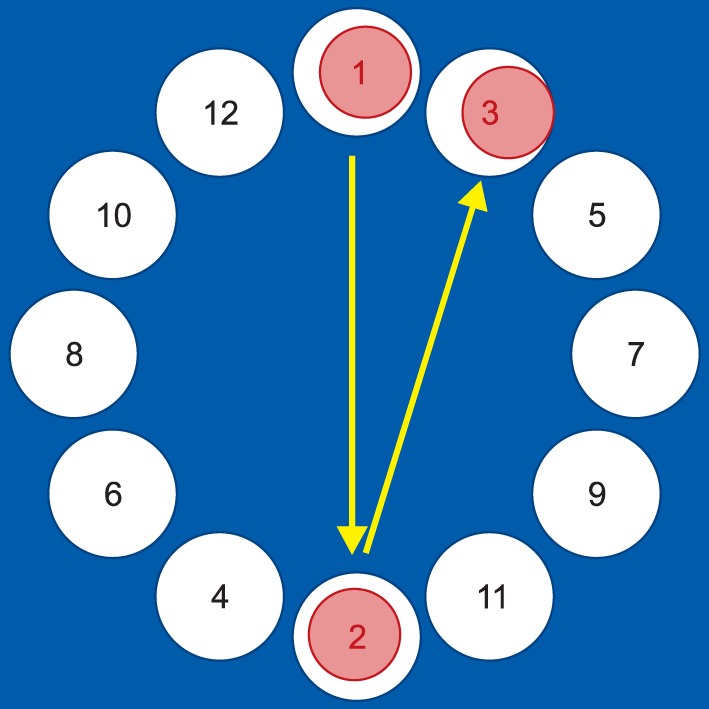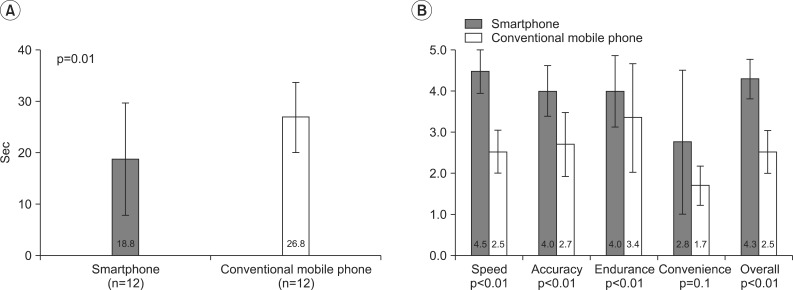Ann Rehabil Med.
2014 Apr;38(2):183-188.
Comparison of the Using Ability Between a Smartphone and a Conventional Mobile Phone in People With Cervical Cord Injury
- Affiliations
-
- 1Department of Rehabilitation Medicine, National Rehabilitation Center, Seoul, Korea. iambs@hanmail.net
Abstract
OBJECTIVE
To investigate the ability of spinal cord injury (SCI) patients in the use mobile cellular devices, especially the smartphone.
METHODS
Seventeen people with motor complete cervical SCI participated in the study. The assist-devices deemed most fitting were introduced to the patients: a mouth stick, multifunctional splint, activities of daily living (ADL) splint, universal cuff or none of the above. To determine the effective devices, a Multi-Directional Click Test (MDCT), Phone Number Test (PNT), and individual satisfaction inquiry were used. The most appropriate assist device was selected by MDCT. Subsequently PNT and individual satisfaction inquiry were performed with the conventional model and compared.
RESULTS
Those with C4 cord injury chose mouth stick. Those with C5 cord injury chose multifunctional splint (3 people) and ADL splint (2 people). Those with C6 cord injury chose universal cuff (3 people) or bare hands only. Those with C7 cord injury chose universal cuff (3 people). With a smartphone, all participants were able to complete the PNT. With a conventional model, only twelve participants (71%) were able to complete the same test. While it took 26.8+/-6.8 seconds with a conventional model to complete PNT, the same test took 18.8+/-10.9 seconds to complete with a smartphone (p<0.05). Overall, participants expressed higher satisfaction when using a smartphone.
CONCLUSION
The results offer a practical insight into the appropriate assist devices for SCI patients who wish to use mobile cellular devices, particularly smartphones. When the SCI patients are given the use of a smartphone with the appropriate assist devices, the SCI patients are expected to access mobile cellular device faster and with more satisfaction.
MeSH Terms
Figure
Reference
-
1. Blain S, McKeever P, Chau T. Bedside computer access for an individual with severe and multiple disabilities: a case study. Disabil Rehabil Assist Technol. 2010; 5:359–369. PMID: 20131978.
Article2. Choi DJ, Jung BM, Lee JW. Evaluation for information gap index on 2012. 1st ed. Seoul: National Information Society Agency;2013.3. Eom GM, Lee JM, Kim CS, Kong SJ, Lee BS, Lee KH. Manipulation performance and satisfaction of the computer mouse interface in the cervical spinal cord injury patients. J Korean Acad Rehabil Med. 2006; 30:230–235.4. Chen HC, Chen CL, Lu CC, Wu CY. Pointing device usage guidelines for people with quadriplegia: a simulation and validation study utilizing an integrated pointing device apparatus. IEEE Trans Neural Syst Rehabil Eng. 2009; 17:279–286. PMID: 19423450.
Article5. Douglas SA, Kirkpatrick AE, Scott MacKenzie IS. Testing pointing device performance and user assessment with the ISO 9241, Part 9 standard. In : Proceedings of the SIGCHI conference on Human Factors in Computing Systems; 1999 May 15-20; Pittsburgh, PA. p. 215–222.
- Full Text Links
- Actions
-
Cited
- CITED
-
- Close
- Share
- Similar articles
-
- The association of usual mobile telephone usage with blood pressure, body mass index, and hemoglobin
- Usage Status and Characteristics of Mobile Devices for the Geriatric Population
- Relationship between the Use of Mobile Phones and Hearing Thresholds in Some White-collar Workers
- Factors related to the Overuse of Mobile Phone in Elementary School Students
- Acute Spinal Cord Injury after Cervical Nerve Root Block




